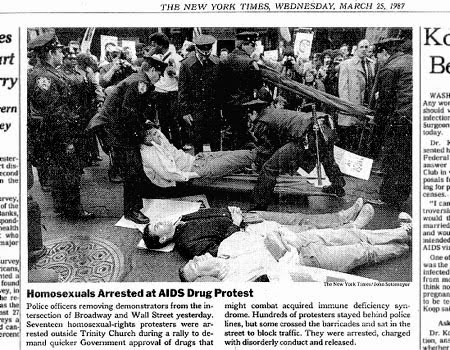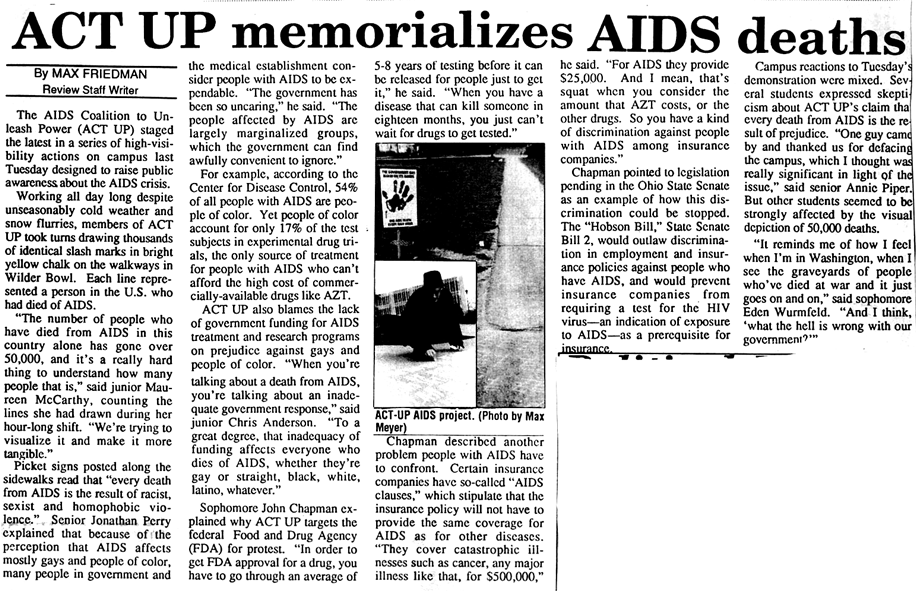a call for ACT-UP style tactics from the ME/CFS community

According to the CFS Untied blog, the CFIDS Association of America just proudly touted an “advocacy” style for ME/CFS that consists of “using one’s inside voice”:
“The president of the CFIDS Association of America said that she heard the announcer on National Public Radio state that “we use our inside voices to bring you the news.” She likened that to the “inside voice” of the CAA as they pursue their activities of stimulating research, reporting on the success of their grantees, and sharing information about upcoming events and important publications.”
A quarter of a decade into the crippling epidemic of ME/CFS, we have yet to learn what AIDS activists taught us about inside voices or, more generally, about interiority from the perspective of men who had come out of the closet only to be faced with social ostracism and Kaposi’s sarcoma. Those activists didn’t use inside voices unless they were watching a live performance of Angels in America. They shouted, marched, and threw blood. And this is what worked.
Because AIDS struck the gay community with such ferocity, the first line political responders to AIDS were heavily invested in the gay community. So gay culture used its own ammunition: the arts, style, radicalism, intellect, and rooted bodily awareness. This launched an activism that was uniquely queer-ified but opened its arms to all affected groups. The gay male community knew how to finger-snap back at homophobia, and took the weapon that had always been used against them — bodily shame and blame — and threw it against their oppressors. They reappropriated derogatory language and smear tactics, so that society could see the smallness of its bigotry — and conversely, where they faced bigotry or stereotyping, they used it. When the New York Times ran a photo caption about the first ACT-UP action in 1987 that read “Homosexuals arrested at AIDS drug protest,” it likely helped the cause by inciting homophobia: gay men were bleeding their gay disease right there in the streets (!), and all they wanted were fast-tracked drugs (!).
When faced with homophobic religious intolerance, these groups came up with a brilliant re-wording of slogans — like putting the phrase “right to life” over the image of a condom, until justice-seeking, open-minded religious figures joined them.

A sort of panic ensued from such ACT-UP tactics, the kind of cultural panic that emerges when any ghettoized group invades an exclusionary space. For a brief time, my guess is that the response of government AIDS officials came right out of their own homophobia: they wanted to do damage control, and quickly, to cram the gay plague back into a hidden arena. Not allowing people to be comfortable with the status quo — in fact, forcing the discomfort of AIDS onto the American public — was what won the war for AIDS activists.
ACT-UP realized their victory came in part from culture’s phobic response — and they capitalized on it, brazenly, exposed it and called it out. They went into every space their queer-infused politic would be unwelcome: Wall Street, Trump Towers, Sloan-Kettering, Northwest Airlines, St. Patrick’s Cathedral, the FDA. They pulled in non-gay members of other disenfranchised groups who were being hit by AIDS and ignored, such as prisoners, IV drug users, people of color. These tactics resulted in fast-tracking of drugs, safer doses of AZT, and cost reductions of overpriced AIDS meds. They never let up on the tone of emergency.
By using an “inside voice” ME/CFS patients and activists have done nothing but reinforce the power of those keeping us down. We too have been faced with bigotry — plenty of it — and derogatory stereotyping. Look at this cartoon, for example — we’ve seen similar stereotypes in the media a hundred times, and it’s a disgrace:

Patients who display appropriate entitlement or speak to the tone of emergency, such as Hillary Johnson or Dr. Jamie Deckoff-Jones, are still sometimes treated as an angry fringe.
Dr. Paul Cheney’s recent newsletter stated — in seeming response to vocal patient Dr. Deckoff-Jones’ blog about her XMRV treatment with antiretroviral drugs — that we (patients) should not trust anecdotal stories of treatment with such drugs, as they could be reflecting spontaneous cures. While it is true that many anecdote-reported “cures” of ME/CFS fall flat, Dr. Cheney (one of our finest) is dismissing a Harvard-educated doctor’s capacity to document the progress of herself and her daughter. Maybe it was a Harvard education that allowed Dr. Deckoff-Jones the appropriate tone of entitlement she is encouraging of other patients, when she states repeatedly that patients should have the right to make a choice about drug treatment without paternalism standing in the way. She’s right, and she’s an example of what one person can do.
This is not just about numbers: a lot of shit can be shaken when each participant chooses a bullhorn, a die-in, even a quilting needle instead of an “inside voice.” Here’s an article about ACT-UP actions at my small college, Oberlin, when I was a student there:

Tory Dent said something profound with the title of her first book of poetry (written from the standpoint of an HIV-positive straight woman), What Silence Equals. AIDS politics had already figured out the literal meaning of silence (death), but Dent turned it into a more deeply philosophical concern. Silence equals a lot of things beyond death. There is a particular kind of silence that wends its way into the shocked dogs known as ME/CFS patients. While most of us are too disabled to do ACT-UP style activism, I have noticed that many patients also think such activism does not apply to them. “Wouldn’t it be more effective to simply hold a meeting?” a patient-activist asked me recently. I think we’ve held plenty of meetings and — as thrilling as some of the challenging questions raised at those meetings have been — they don’t replace the grit and gusto of ACT-UP style tactics. We have to claim our outsider status, and work with it.
Meetings miss the point entirely in most cases, as they show patients acting more healthy than they are. At 41 years old, after publishing three books, I am so cognitively impaired I resemble someone with AIDS neurocognitive dysfunction — a reality that makes sense if one looks at Dr. Komaroff’s SPECT scans of the brains of people with ME/CFS and AIDS dementia (they look identical) — and I have a hard time following a meeting. Plus I can’t travel. I am bedridden almost all of the time. My life has been whittled down to an arrow-sharp emergency, and I’m not going to use my inside voice about it.
Many of us have been forced into solitude and extreme interiority. But there is another piece of this, the despair, and the idea that we can’t really shake up change. Maybe one had to live in that ground zero of San Francisco in the 80s or early 90s as I did to really appreciate how effective AIDS activist tactics were, and where they came from. As battle-weary as some activists were by the time I arrived in the city in 1992, AIDS was still as ubiquitous in San Francisco as coffee was about to become in Seattle. HAART had not come along yet and people were dying. There was no time to hide these realities of the flesh, and no time to be quiet.
Here’s an ad that the San Francisco AIDS Foundation took out in SF papers in 1992 and another SF AIDS Foundation poster from 1994 and: another.
This is how far even the more moderate AIDS organizations had gone, by the early 90s, beyond an “inside voice.”
And this piece by artist John Davis, from 1992, says it all about amplifying an inside voice: it depicts a nude wasting AIDS patient hiding his face from the camera.
In the Castro, the juxtaposition of life and death in the AIDS era was particularly cruel, because the men who looked so virile and green-drink-purified and gym-toned were window-shopping right alongside the men in wheelchairs with Kaposi’s sarcoma lesions and oxygen tanks. The Golden Gate bridge was constantly repainted a fiery red, and if one took a quick turn off of Castro onto Market Street, one could see the sewing machines in the windows of the Names Project (the AIDS quilt) inviting the same kind of fiery artistry against the fog — all fog that obfuscated the bloody truth.
But even in a city where half of the gay men were then said to be HIV positive (I don’t know where that statistic came from, but heard it repeated more than once in San Francisco), the epidemic was also remarkably invisible at times. Yes, patients were wasting and dying with visible lesions, but before that they were the well-looking patients coming into the health food store where I briefly worked, flashing AIDS discount cards and buying weight gain powder. At that moment, they were not unlike a lot of ME/CFS patients, even in San Francisco.
It is not that they were not alone, and invisible, but that they spoke openly, honestly, and angrily about this truth, as described in this speech by Vito Russo in 1988: “Living with AIDS is like living through a war which is happening only for those people who happen to be in the trenches. Every time a shell explodes, you look around and you discover that you’ve lost more of your friends, but nobody else notices. It isn’t happening to them. They’re walking the streets as though we weren’t living through some sort of nightmare. And only you can hear the screams of the people who are dying and their cries for help. No one else seems to be noticing.”
They made themselves visible.
The government tried to give AIDS a belittling misnomer, just as they did with “CFS,” when they called it gay-related immune deficiency (GRID). The acronym GRID seems to encode its secret purpose: to keep the gay plague cordoned off. “CFS,” in its own way, did the same thing: it created a tidy idea for a devastating, chaotic situation — like a codependent wife trying to diffuse the alcoholic dervish she married through using his tactics of denial, minimizing, and blame.
AIDS patients responded with a savvy ability to seize what was given to them and flip the language around. If the government was going to call it a gay plague, then fine: gay men started the Gay Men’s Health Crisis which morphed into ACT-UP. They seized reductionistic language and twisted it around, with passion and anger. The world wanted to see dying gay men kept in a constrained, leper-colony-style grid: so they decided to “unleash power” and define their own crisis.
A quarter of a century into our epidemic, we still have newspapers shortening their headlines about this illness to “chronic fatigue.” This is degrading language, and we can’t let it go unnoticed.
In the current flurry of articles about homophobic bullying and gay teen suicides, it’s important to consider that many of those men with AIDS had been bullied as teenagers, harassed, shamed, and beaten down (literally). Bullies use the same tactics of batterers, and of the CDC — including “denial, minimizing, and blame” (a classic entry on the “power and control” wheel that describes patterns of domestic violence). The power of ACT-UP and other efforts of a besieged gay community came from the ability of afflicted gay men to recognize a bully and know what kind of bear they were up against. Most of them, sensing the bully was a bear who would try to shrink them down, acted big and rattled pans.
But ME/CFS patients have tended to get sucked into what domestic violence activists call the “cycle of violence,” believing the bullies’ lies that they will change — lies like “Ampligen will be approved by the FDA soon!” and “the CDC will make a concerted effort to restore the misspent funds to further research around ME/CFS.” It’s time for the abuse cycle to stop. Lundy Bancroft wrote in his seminal book about abusers, Why Does He Do That?, “You cannot, I am sorry to say, get an abuser to work on himself by pleading, soothing, gently leading, getting friends to persuade him, or using any other nonconfrontational method. I have watched hundreds of women attempt such an approach without success. The way you can help him change is to demand that he do so, and settle for nothing less.”
The best way to end Stockholm Syndrome is to get the hell out of Stockholm, or Dodge, or the CDC’s bed.
ME/CFS activism has done far too much pleading, soothing, and gently leading. The bullies that dragged their feet around AIDS underestimated the power of gayness, expecting it to be more passive than it was. They had never been to the Castro, and had not met superhuman men who could lay hardwood floors, bench press a ridiculous amount, fuck like the ship was sinking, pick out the right paint colors, and dress to the nines. But it wasn’t just the gay men: it was artists, other queer folks, anarchists, and growing legions of sympathizers and infected parties. The AIDS movement was like a Harlem Renaissance of arts and culture exploding, and the CDC and NIH and FDA were completely unprepared. They had not really considered what would happen if gay men stopped being their hairdressers and turned their shears on FDA red tape. But this is exactly what happened.
And this was exactly the beauty of AIDS activism: it brought together hairdressers and quilters, junkies and mothers. People found creative ways to use whatever skills they had — and ME/CFS patients can do this too, even if we can only lie still with a webcam trained on us.
We can’t believe it’s too late to start over, and have a movement that strong. We have to demand change and settle for nothing less.
One reason outsiders joined AIDS politics is that AIDS politics were radical, artistic, and cool. ME/CFS now has a retrovirus that starts with the letter X — X like an LA punk band, X like the X Games, X like the eyes of the dead in a graphic novel — and we have a chance to escape the hysterian-invoked stereotypes that have held us down for so long. We have to call this what it is, call it X Disease, call it XAND, and use that X like a medieval weapon.
Yes, we have been living an imposed dormancy for decades. This is our time to wake. I dare say that if Sophia Mirza’s mom can tell the story of her daughter’s death from ME/CFS when her daughter’s last months were spent in complete confinement, or if Laurel can present this testimony to the CFSAC while too ill to speak above a whisper, or if I can write this blog post after spending most of 2009 lying ten hours a day on a bathroom floor as far as I could drag myself from bed, unable to speak and in respiratory failure dying a horrible death, every patient and every family member of a patient can play a role in this struggle.
I want to see the recent email campaigns and other actions take off, but I also want to see a radical politic with a lot of new ideas that loudly speak the awful truth. I want to see patients spray-painting an X over themselves and doing living-death die-ins (Krylon H20 Latex spray paint has much lower VOCs) with signs that say “This living death is XMRV.” I want to see a tech savvy ME/CFS patient put up a virtual quilt video project, where one patient wears a green t-shirt with an X on it and another wears a red one and another wears a blue one as each of them tells a one-minute XMRV/ME/CFS story, and these screens are quilted together on one big web page.
Now AIDS has given us a road map for activism, and it has even given us Anthony Fauci, who Russo critiqued in his aforementioned speech by saying: “And we read on the front page of The New York Times last Saturday that Anthony Fauci now says that all sorts of promising drugs for treatment haven’t even been tested in the last two years because he can’t afford to hire the people to test them. We’re supposed to be grateful that this story has appeared in the newspaper after two years. Nobody wonders why some reporter didn’t dig up that story and print it 18 months ago, before Fauci got dragged before a Congressional hearing.”
It was at that moment in history that AIDS activists began screaming for drug trials — not agreeing that they were supposed to be grateful for one damn story. It’s discouraging to see ME/CFS patients get so excited about this “world class virus hunter” heading up the latest XMRV research when no drug trials are underway. If patients need something to light a fire under their activism, I suggest looking at the text of this ACT-UP flyer for their first organized action March 24, 1987 on Wall Street, New York City — it mentions Ampligen. Yes, that’s right, Ampligen — the drug found to have efficacy against XMRV that ME/CFS patients can’t get except through limited cost-recovery trials — the drug kept from ME/CFS patients by FDA foot-dragging while no other drugs have been approved by the FDA for this disabling and potentially contagious retrovirus.
So how well have our tactics worked so far?
Flyer for the First ACT-UP Action on March 24, 1987, Wall Street, New York City
NO MORE BUSINESS AS USUAL!
Come to Wall Street in front of Trinity Church
at 7AM Tuesday March 24 for a
MASSIVE AIDS
DEMONSTRATION
To demand the following
1. Immediate release by the Federal Food & Drug Administration of drugs that might help save our lives.
These drugs include: Ribavirin (ICN Pharmaceuticals); Ampligen (HMR Research Co.); Glucan (Tulane University School of Medicine); DTC (Merieux); DDC (Hoffman-LaRoche); AS 101 (National Patent Development Corp.); MTP-PE (Ciba-Geigy); AL 721 (Praxis Pharmaceuticals).
2. Immediate abolishment of cruel double-blind studies wherein some get the new drugs and some don’t.
3. Immediate release of these drugs to everyone with AIDS or ARC.
4. Immediate availability of these drugs at affordable prices. Curb your greed!
5. Immediate massive public education to stop the spread of AIDS.
6. Immediate policy to prohibit discrimination in AIDS treatment, insurance, employment, housing.
7. Immediate establishment of a coordinated, comprehensive, and compassionate national policy on AIDS.
President Reagan, nobody is in charge!
AIDS IS THE BIGGEST KILLER IN NEW YORK CITY
OF YOUNG MEN AND WOMEN.
Tell your friends. Spread the word. Come protest together.
7 AM … March 24 … You must be on time!
AIDS IS EVERYBODY’S BUSINESS NOW.
The AIDS Network is an ad hoc and broad-based community of AIDS-related organizations and individuals.









way to go peggy… how come nobody mentions 45% of the hiv virus envelope that dr. gart nicolson found in cfs/gulf war illness over 10 years ago… talk about a cover-up and all the pieces of bacterias and viruses he also found inside this envelope… the truth is they created aids and cfs in a u.s. military lab… i really wonder now how many more army personell and including family members are coming down with these illnesses… i am now surprised that all these forces are mostly finished and on their way home and maybe it is about time that the troops deliver some shock and awe campaign attitudes right to the doors of these useless idiots at the c.d.c./n.i.h. and f.d.a. offices… maybe that will wake these s.o.b.’s. up once and for all… i personally do not believe in xmrv/mlv but believe in a piece of the aids virus garth already found… remember mycoplasmas for years have been associated with aids and this is exactly what cfs is and that is a form of aids… remember this; what are the aids drugs suppose to be working on in cfs… i will bet my life it is not xmrv/mlv but 45%of aids virus found by garth and nancy’s gene tracking methods… to all you troops coming home i can only suggest you all do something before you and your families start getting symptoms like numerous troops have already got before it is to late… of course you can all come home and sit on your asses and do nothing or you can be real men/women and start demanding some immediate answers and the real truth on why thousands of your teams have been infected and dieing and your useless governments did nothing for these troops but dismissed them and forgot them and their sick families all around the world… wake up people, you all are probably next to be sick… next time your dog gets sick maybe he is coming down with a piece of the aids virus… remember what suddam told all of you and the world; come to the gulf and there will be a surprise… you can all thank the both bush’s for all of this because bush sr. sold these to suddam to use on the iranians… i only hope all of you do something before it is to late… think about your families and loved ones… god bless all of you… sincerely aidan walsh southampton, united in the kingdom, u.k. p.s. support garth and nancy, they are very truthful people and warm scientists who care about all of you and your loved ones… be well all of you……
another interesting site i cam across and am trying but to early to say it will work but has helped in some symptoms… i can only suggest people try this as it does not cost and you have nothing to loose… by the way, this doctor was pushed aside by the n.i.h. because i now believe he was a threat to them and the pharma industry… http://www.watercure.com http://www.watercure2.org “chronic unintentional dehydration” think the next time you take “hystamine” drugs as this doctor concluded after 20 years of serious research that these drugs were total scams and the pharma industry knows this but only are interested in their huge profits and suckers who will take them… god bless all of you and be well… sincerely aidan walsh southampton, united in the kingdom…p.s. since using watercure i am down to lowest dose of prednisone in 20 years and soon off for good!! at only 5 mg. now…
the one major difference between aids and me/cfs is that aids arose in a primarily marginalized group (gay men) and me/cfs arose in the mainstream establishment (white middle-class). the comfortable mainstream does not know how to be activists. activism is born of disenfranchisement and discomfort; people who are comfortable have no need to rock the boat. the establishment’s primary language, the one we have been speaking all our lives, is the “inside voice.” we have been thrust into a foreign country, at a loss to pick up the language.
(ill with me/cfs since 1978)
Interesting article. I do suffer from CFS/MCS.
Living a pretty normal life now, I can only say: Do NOT take any pharmaceutical drugs (our bodies are just not made for chemicals and unnatural stuff). Find the cause and make a change in your lifestyle and environment.
Detox, detox, detox, change of diet and find a GOOD doctor who can test what YOUR body needs. Fix one weak link after the other. A positive outlook. Don’t give up and don’t pity yourself. It is not the whole world that is bad and dangerous, it is just some circumstances that are unhealthy.
Every patient and every human in general is unique. What works for one may not work for others, but the overall treatment is the same.
http://www.wholebodycures.com/
Peggy, thank you for this article. It was fascinating, and the lesson that “inside” voices rarely change the status quo that you’re pulling from ACT-UP and the activism surrounding AIDS should translate to your community as well. You have some great ideas (you’re right on about the “X”) and your video quilt project sounds amazing. Another parallel you might consider to the activism of the GLBTQ community is rallying ALLIES.
Namaste,
Lee